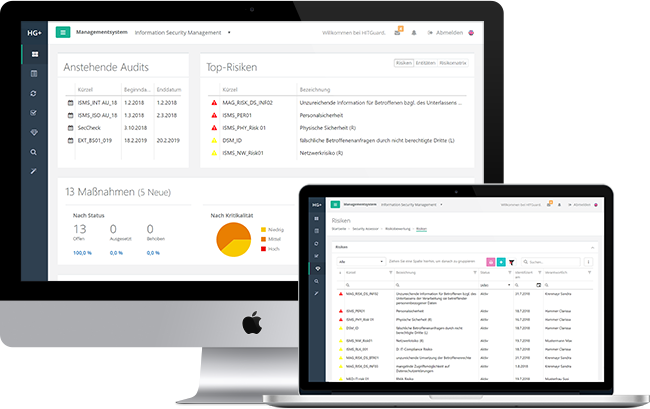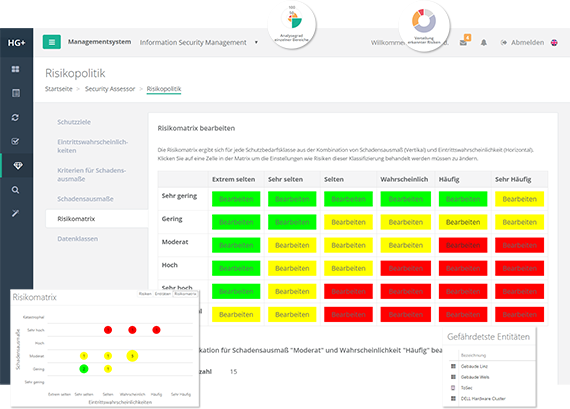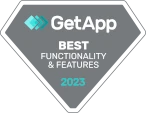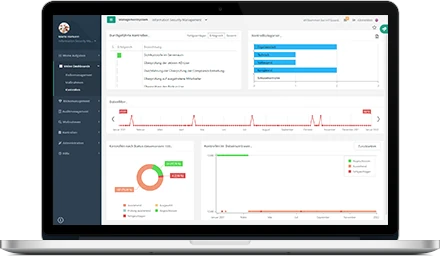Risk management
The HITGuard risk management software maps the risk management process in accordance with ISO/IEC 31000 with workflow support. The software uses knowledge databases to identify and analyze risks and to derive measures and controls. HITGuard thus supports you in analyzing, evaluating, monitoring and control your business risks.
- Risk identification with the aid of knowledge databases
- Risk analysis and assessment within the framework of a freely configurable risk matrix
- Risk reduction by means of own and proposed measures
- Risk monitoring through repeatable controls
- Historically comprehensible development of risks

Testimonials

G.I.P. S.à r.l.
We have been recognized by Gartner Digital Markets as a 2023 "Best of" award winner for the top-rated products in the "Risk Management" category!
The "Most recommended" and "Best functionality & features" badges are based on verified user reviews on Gartner's websites and recognize the software products that offer the best usability and functionality in their respective categories.

Risk Identification
In the course of risk identification, risks are identified and recorded using knowledge databases or other risk analysis methods.
- Draw on industry-specific proven expert knowledge to help you identify potential risks with audit questions.
- Delegate deviation analysis and business impact analysis to stakeholders through self-assessments.
- Use checklists to ensure compliance with guidelines, project standards, and internal guidelines.
- To do this, create your own knowledge bases or use existing ones.
Risk Analysis & Assessment
The risk assessment matrix according to probability of occurrence and extent of damage, which is used for risk analysis and assessment, can be configured entirely according to your ideas. This results in a ranking of the risks according to their risk ratios. The top risks are always present on the dashboard at first glance.
- Use a freely configurable risk matrix to determine when a risk becomes threatening to your company.
- Adapt the development of your risk management to your current level of maturity.
- Always keep an eye on your risks and their development, even over time.
- Use workflow support to keep the risk assessment up-to-date together with the risk owners.


Risk Reduction & Monitoring
The identified deviations are bundled into risks in the risk analysis and assessment. The knowledge bases contain suggestions for action and control on how to counter these deviations. These suggestions can be adopted and adapted to the requirements of the company.
- Create risk reduction measures and monitor their implementation with your Risk Treatment Plan.
- Create recurring controls that allow managers to monitor identified risks or protective measures.
- To do this, use suggested measures and controls from the knowledge databases or create your own measures and controls.
- Share risks with other management systems if they are relevant beyond their own scope of application.
Interactive Risk Graph
HITGuard uses the results of business impact analyses to map the dependencies between organizational units, processes, data, and systems. By linking these elements to identified risks, the direct and indirect effects on OUs, processes, systems and data can be identified.
- Identify dependencies in the organizational structure at a glance.
- Immediately see how risks affect parts of the business.
New perspectives
Defined experts from different management systems as well as managers can view the risk graph. As a result, people with different perspectives have access to the current risk situation of the entire company. The different perspectives complement each other and allow new conclusions, for example on the occurrence of identified risks in other management systems.

Individualized assessment
The risk assessment in HITGuard depends on the desired level of maturity of the respective management system and company-specific assessment schemes. For example, the maturity level of an information security management system at the time of initial certification according to ISO/IEC 27001 is different from the maturity level of the repeated recertification audit. These changing requirements can be mapped, tracked and evaluated in HITGuard for a wide variety of standards and norms as well as your own internal specifications. HITGuard adapts to your needs, not the other way around!
Evaluation and analysis options
HITGuard maintains a strict documentation and historization of developments in your risk management. It also allows the archiving of development statuses at the time of analysis for the purpose of comparability. This makes it possible to carry out evaluations, such as the presentation of a maturity development of an information security management system, for example compared to the ISO/IEC 27001 standard, over several periods. No matter which norm, standard or internally created specifications you want to increase your level of maturity, HITGuard allows you to evaluate this. The insights gained from this can be helpful to company management as well as during audits and certifications.
Learn more about others Modules from HITGuard!
Request a non-binding demo now
Find out what the GRC software HITGuard can do for you


